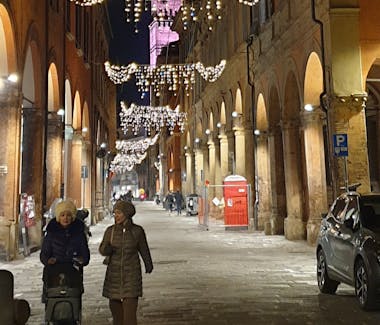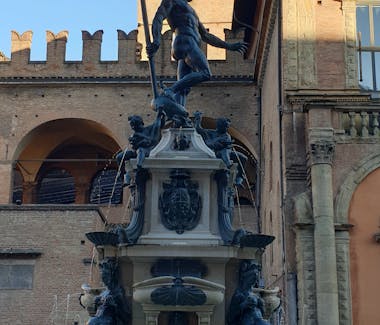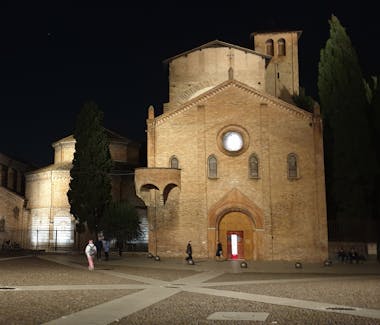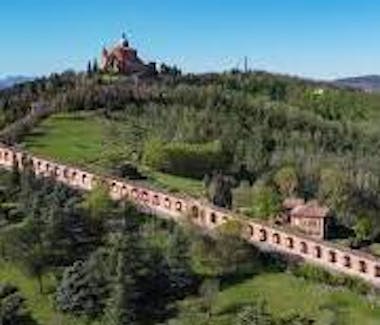Attractions



Torre degli Asinelli e Torre Garisenda, Piazza di Porta Ravegnana, Bologna, Metropolitan City of Bologna, Italy
Le due Torri
The two Towers are commonly recognized as symbols of Bologna and are located in the heart of the city at the point where the ancient Via Emilia (Aemilian Way) entered the city.
They were built during the Middle Ages and had a military function (signalling and defence) as well as representing, with their grandeur, the social prestige of the family that had built them.
ASINELLI TOWER (TORRE DEGLI ASINELLI)
The Tower was built between 1109 and 1119 by the family bearing the same name and was handed over to the Municipality as early as the following century. 498 internal steps lead to the top at a height of 97.02 metres offering spectacular views of the city.
GARISENDA TOWER (TORRE GARISENDA)
Built at the same time as the previous tower, is different due to its shorter height of 47 metres. It is known for its steep overhang due to a subsidence of the land and the foundations, so much so that Dante featured it in Canto XXXI of the Inferno. It was lowered for fear of it collapsing during the 14th century and is currently being restored.








Piazza Maggiore, 40124 Bologna BO, Italy
Piazza Maggiore
The heart of the city, Piazza Maggiore is the result of centuries-old transformations that gradually enriched it with important buildings: the Basilica of San Petronio, the Palazzo dei Notai, the Palazzo d’Accursio, the Palazzo del Podestà and the Palazzo dei Banchi.
It dates back to 1200, when the Municipality began to acquire houses and land to build a square, which, on one hand, was to represent the importance of the municipal institution and, on the other, was to bring together the various city activities (exchanges, trade and services of various kind).
Only from the 16th century did it begin to be known as Piazza Maggiore, even if the name of the King of Italy, Vittorio Emanuele II, was attributed to the square from the expulsion of the Austrians in 1944. So only starting from 1945 did the square and the immediately surrounding area begin to be officially known with the current name: Piazza Maggiore.
The Fontana del Nettuno (Fountain of Neptune), made of marble and bronze, was built between 1563 and 1566 by the Flemish sculptor Giambologna on a project by Tommaso Laureti. It is a symbol of the power of the Pope who ruled the world like Neptune ruled the seas. At the feet of the statue, in fact, lie four little angels, representing Gange, the Nile, the Amazon and Danube, i.e. the rivers of the continents known at the time.



Via Santo Stefano, 24, Bologna, Metropolitan City of Bologna, Italy
Basilica di Piazza Santo Stefano (Le Sette Chiese)
Piazza Santo Stefano is one of the symbolic places of Bologna, commonly considered a square, even if it is actually an open space originating from Via Santo Stefano and leading to the complex that bears the same name, also known as the “Seven Churches”.
Dominated by the Basilica of Santo Stefano, the square has on one side Casa Berti, Palazzo Isolani and Palazzo Bolognini Isolani, and, on the other, the 16th century Palazzo Bolognini Amorini Salina.
Today the square is often used to host cultural events and concerts.
Santo Stefano is the most unique complex in Bologna, as it is a true city sanctuary and the cradle of our ancestor’s faith. It is mainly known as “sette chiese” (“seven churches”) because it is the merger of multiple buildings erected in different eras.
The origins of the complex are controversial and disputed. According to the most accepted theory, it was built by Petronius on the ruins of a pre-existing pagan temple, flanked by a reproduction of the Holy Sepulchre in Jerusalem. Next to the sacellum with the remains of Bologna protomartyrs Vitale and Agricola we find the buildings erected by the Benedectines between the 10th and 13th centuries.
The square is overlooked by the Church of the Crucifix of Lombard origin, the Church of the Calvario, the Church of Saint Vitale and Saint Agricola and the Church of the Trinity (Chiesa della Trinità) restructured between the 12th and 13th centuries. Inside, you can also admire the Courtyard of Pilate (Cortile di Pilato) with a marble basin donated by Liutprand and Hildeprand, Kings of the Lombards, and the Benedectine cloister with a dual loggia (10th-13th centuries), one of the most superb creations in the Aemilian Romanesque style. There is also a Museum displaying paintings, sculptures and other artworks from various eras.






Santuario della Beata Vergine di S. Luca, Via di San Luca, Bologna, Metropolitan City of Bologna, Italy
Portico della Madonna di San Luca
The Sanctuary of San Luca, located on Colle della Guardia, has been the symbol of Bologna as well as a place of religious worship for centuries. It is connected to the city centre by a road that, starting from Porta Saragozza, unwinds for four kilometres with a portico that boasts over 600 archways and is the longest in the world. Together with the other city porticoes, it was included in UNESCO World Heritage Site list in 2021.
The portico started being built in 1674 and, during Ascension week, a procession has been walking along it carrying the Byzantine Madonna with Child to the Cathedral since 1433. The Sanctuary church was, however, built later in the 18th century to replace a previous 15th-century construction.
The sanctuary offers marvellous views over the surrounding landscape. In addition, the panoramic terrace opened in 2017 at a height of 42 metres above Colle della Guardia (300 m asl), enables visitors to admire a unique 180° view of Bolognafrom the hills to the centre stretching out as far as Casalecchio di Reno.

Via Zamboni, Bologna, Metropolitan City of Bologna, Italy
Via Zamboni
Via Zamboni (Strè San Dunè in bolognese) è una strada storica del centro di Bologna, compresa nel quartiere Santo Stefano, che va dalle due Torri fino a Porta San Donato. Prende il nome dal patriota Luigi Zamboni ed è lunga circa un chilometro.
La via è conosciuta per essere l'arteria principale della zona universitaria; attorno ad essa si dispiegano infatti numerosi edifici dell'Università di Bologna ospitanti biblioteche, dipartimenti e altri servizi, oltre a Palazzo Poggi, sede del rettorato.